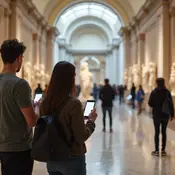Attentive museum visitors may have already noticed: German museums gradually join the efforts of public institutions to promote sustainable mobility. By charging stations at your locations, you support the use of electric vehicles among visitors by enabling charging during the stay.
In this way, environmentally friendly means of transport are worked towards and museums are strengthened as sustainable facilities. This infrastructure helps to reduce carbon emissions and enables museums to modernize their image by presenting innovative technologies.
This article presents how museums as a pioneer for modern, sustainable mobility and actively contribute to promoting electromobility.
Current situation of the charging infrastructure at German museums

In recent years, many German museums have actively tried to promote sustainable mobility by building charging infrastructures for electric cars in their parking spaces and near their locations. These measures help to reduce CO2 emissions and at the same time offer visitors a practical way to charge their electric vehicles during their museum stays.
Power providers actively support these measures, for example by promoting Wallbox or charging column connections on the museum site.
Examples of museums with charging stations
Folkwang Museum in Essen
As part of the initiative to promote sustainable mobility, the E.ON Foundation at Folkwang Museum in Essen has installed a charging station. This initiative is part of a larger project that also includes the development of a CO2 computer for museums.
The CO2 computer is intended to help calculate and reduce the ecological footprint of the museums. E.ON's charging stations on Folkwang Museum offers visitors the opportunity to charge their electric cars during their museum visit and is a step towards a more environmentally friendly future.
Hamburger Kunsthalle
In 2023, Vattenfall and the Hamburger Kunsthalle together created a charging infrastructure for electromobility. The Hamburger Kunsthalle not only shows its commitment to sustainable mobility, but also its willingness to integrate innovative technologies and offer their visitors an additional service.
Buchheim Museum in Bernried
The Buchheim Museum in Bernried is one of the pioneers when it comes to the integration of e-charging stations to museums in Germany. Visitors find several charging stations for electric vehicles there, three of them with a high capacity.
Also worth mentioning are the two additional charging stations in the disabled park area, which support accessibility. This not only promotes environmentally friendly journey, but also access for people with disabilities.
German Museum in Munich
Another impressive example is the German Museum in Munich. Not only are electrical phenomena such as lightning strikes presented clearly, but the importance of electromobility is also illustrated.
With the powerful acronym Sven- Shared Vehicle Electric Native- FeV presents itself- a global engineering service provider in vehicle and drive train development as well as for digital mobility- as a pioneer in the field of car sharing by developing an innovative electrical vehicle concept for the urban mobility of the future. The curators of the German Museum in Munich share this conviction and have selected "Future of Mobility" (see press release from FEV ).
In Hall 1 of the traffic center, visitors can admire this pioneering FEV vehicle and learn how to design the future of city traffic. With Sven, FEV not only set new standards in terms of sustainable mobility, but also presents a visionary concept that could revolutionize mobility in urban rooms.
The charging stations at the Deutsches Museum are a matter of course among the museum's sustainability efforts in relation to mobility.
Technology Museum Berlin
The Technikmuseum Berlin offers a wide range of loading points in the entire parking area, which encourages visitors to use environmentally friendly means of transport. These measures illustrate the successful combination of technological innovations and cultural heritage in order to give museum visitors an environmentally friendly journey.
These examples of the charging stations of E.ON and Co. show that museums in Germany are increasingly recognizing the importance of sustainability and taking measures to promote the use of electric vehicles. By providing charging infrastructures, you make a valuable contribution to reducing CO2 emissions and set an example for progress and modernization of cultural institutions.
Future prospects and challenges
The modernization of old buildings and historical systems is often complex. Acceptance problems among museum visitors and employees can make implementation difficult because electric vehicles are not yet widespread everywhere. Laws and financing hurdles also slow down the expansion.
Despite these obstacles, innovative solutions such as the use of renewable energies and modern charging technologies offer promising approaches.
Continuous training and sensitization in the field of electromobility are crucial for the future. Projects often require considerable investments, which makes financing a central challenge. However, funding programs and cooperation with the government, but the electricity providers and private partners can offer the necessary support.
It will also be important to continuously adapt and develop the infrastructure in order to meet the growing requirements.
Conclusion: culture and progress go hand in hand
German museums play an important role in promoting sustainable mobility. With the installation of e-charging stations on your site, you support environmentally friendly arrival options and strengthen your image as modern, sustainable facilities.
Examples such as the Folkwang Museum, the Hamburger Kunsthalle and the Technikmuseum Berlin show in cooperation with providers such as E.ON how these measures are successfully implemented. Despite challenges such as financial hurdles and acceptance problems, cooperations with electricity providers and innovative solutions offer promising perspectives.
The continuous adaptation and further development of the infrastructure will be decisive in order to meet the growing requirements.

Owner and Managing Director of Kunstplaza. Publicist, editor, and passionate blogger in the field of art, design, and creativity since 2011. Successful completion of a degree in web design as part of a university program (2008). Further development of creativity techniques through courses in free drawing, expressive painting, and theater/acting. Profound knowledge of the art market through many years of journalistic research and numerous collaborations with actors/institutions from art and culture.

















